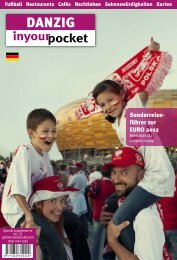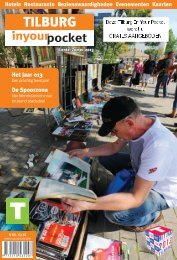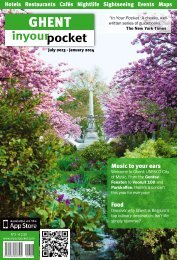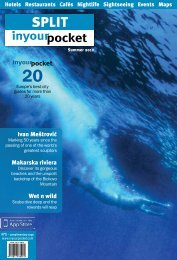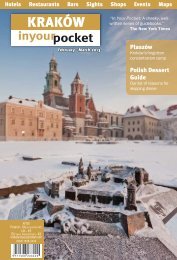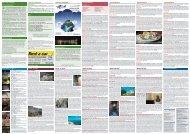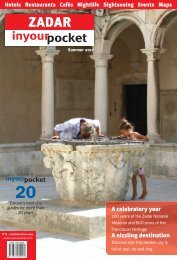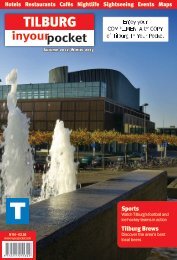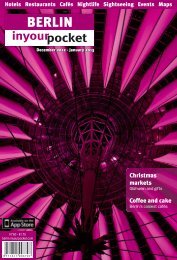7kh 7ul flw\ v prvw dxwkhqwlf 7h[ 0h[ uhvwdxudqw ... - In Your Pocket
7kh 7ul flw\ v prvw dxwkhqwlf 7h[ 0h[ uhvwdxudqw ... - In Your Pocket
7kh 7ul flw\ v prvw dxwkhqwlf 7h[ 0h[ uhvwdxudqw ... - In Your Pocket
You also want an ePaper? Increase the reach of your titles
YUMPU automatically turns print PDFs into web optimized ePapers that Google loves.
136 FROMBORK<br />
Located in the province of Warmia about 100km east<br />
of Gdańsk, evidence suggests that Frombork (German,<br />
Frauenburg) was settled long before the town known as<br />
Civitas Frowenburg was first mentioned in a document dated<br />
1278. Established as the seat of the Warmia bishopric in<br />
the same year, Frombork received its civic (Lübeck law)<br />
rights in 1310. A once much coveted defensive stronghold,<br />
Frombork has seen more than its fair share of war, plunder<br />
and destruction, having been ruled by the Teutonic Order,<br />
Royal Prussia, Germany and Poland to name but a few over<br />
the centuries. Traditionally the home of merchants, farmers<br />
and fishermen, Frombork’s most illustrious inhabitant was<br />
the astronomer and mathematician Nicolaus Copernicus<br />
(Polish, Mikolaj Kopernik), who lived and worked as a priest in<br />
Frombork as well as writing his De Revolutionibus Orbium<br />
Coelestium in the town. Almost completely destroyed during<br />
WWII, since becoming reincorporated in Poland Frombork has<br />
developed into a peaceful seaside tourist destination with<br />
an intriguing astronomical twist. Less than two hours from<br />
Gdańsk, Frombork is a pleasant and decidedly quirky place<br />
to visit any time of year.<br />
Arriving in Frombork<br />
You can get to Frombork from Gdańsk using one of the 4 daily<br />
PKS buses which leave from the main bus station. Between<br />
mid-May and mid-September there is also a ferry service<br />
which runs from Krynica Morska.<br />
By bus<br />
Buses leave Gdańsk’s main PKS bus station at 09:50, 13:00,<br />
16:35 and 19:15, returning at 07:12, 08:43, 12:53 and 15:28.<br />
The journey time is just under two hours. Taking the earliest<br />
bus to Frombork and the latest one back gives you about<br />
four hours in town, which is just about enough to cover the<br />
main sights without having to stay the night. Please note that<br />
the schedule is due to change at the end of June so please<br />
check with the bus station.<br />
By car<br />
Take the E75 out of Gdańsk in the direction of Warsaw. At<br />
Elbląg your luck runs out and it’s a series of thin and bumpy<br />
roads the rest of the way. Take a right onto Route 22 just<br />
after Elbląg then a left onto the tree-lined, pothole-ridden<br />
Route 505 a few kilometres further along. Route 505 takes<br />
you all the way into the centre of Frombork. Depending on the<br />
traffic, the journey takes somewhere in region of 90 minutes.<br />
What to See<br />
Besides the opportunity to enjoy the coastline around Frombork<br />
the only real draw is the spectacular Cathedral Hill, which<br />
offers a number of attractions from the Cathedral itself to<br />
an array of Copernicus-related treats.<br />
Cathedral Hill<br />
Cathedral (Archikatedra Warmińska) ul. Katedralna<br />
8, tel. (+48) 55 244 44 24, www.frombork.info.pl.<br />
Frombork’s massive 14th-century Gothic Cathedral (1329 -<br />
1388) is the main focal point of the town. A masterpiece of<br />
brickwork, the breathtaking interior is packed with Baroque<br />
altars and tombstones, and features a gigantic 17th-century<br />
Baroque organ, one of the most famous organs in the country.<br />
Recitals are often given, and the Cathedral plays host to<br />
an annual organ festival during the summer. The key sight<br />
now is the grave of Nicolaus Copernicus himself which can<br />
be found in the South Nave. Located in the spot where the<br />
remains were discovered that were finally proved to be those<br />
of Copernicus, the grave features a black granite tombstone<br />
which identifies the great man as a canon and the man who<br />
discovered the heliocentric theory. The tombstone bears a<br />
representation of Copernicus’ model of the solar system - a<br />
golden sun encircled by six planets. Q Open 09:00-15:30,<br />
Sun 10:00-18:00. No visiting during mass please. Last entrance<br />
30 minutes before closing. Admission 6/3zł. Sun free.<br />
Cathedral Hill. Cathedral Hill (Wzgórze Katedralne) is the<br />
collective name for Frombork’s famed development complex<br />
composed of a medieval cathedral, bishopric palaces, diocesan<br />
chanceries, defensive walls, towers and keeps. Dating from at<br />
least the 14th century, this was where Copernicus was believed<br />
to have worked, and is therefore something of a shrine for<br />
Copernicus fanatics the world over. Remarkably, Cathedral Hill<br />
was practically the only part of Frombork left standing at the<br />
end of the Second World War. With no explanations in English<br />
you might wish to consider using a tour guide. Local expert<br />
Stanisław Kuprjaniuk is the very man for the job. Call him in<br />
advance one day before you want to visit on tel. 609 68 33 13.<br />
Copernicus Museum (Muzeum Kopernika) ul. Katedralna<br />
8, tel. (+48) 55 244 00 75, www.frombork.art.<br />
pl. Housed in the former Bishop’s Palace, this rather sparse<br />
collection of Copernicus-related paraphernalia includes<br />
several likeness of the great man including Teodor Rygier’s<br />
eerie 1893 miniature of Copernicus dead in a chair. Other<br />
treats include samples of Copernicus’ writings, telescopes<br />
and medals, all of it unfortunately explained in Polish and<br />
German only. Q Open 09:00 - 16:30. Closed Mon. Last<br />
entrance 30 minutes before closing. Note opening hours may<br />
be extended in July. Admission 6/3zł. Wed free.<br />
Radziejowski (Belfry) Tower (Wieża Radziejowskiego)<br />
ul. Katedralna 8, tel. (+48) 55 244 00 75,<br />
www.frombork.art.pl. <strong>In</strong>side is what many believe to be the<br />
best planetarium in Poland, equipped with precise Carl Zeiss<br />
machinery that projects images of the sky onto the eight-metre<br />
domed ceiling, and a replica of Focault’s pendulum, proving<br />
beyond doubt that the earth is in a state of permanent rotation.<br />
Maps & Money<br />
The excellent Pilot map of Elbląg is available in most<br />
bookshops in Gdańsk for about 9zł, and includes street<br />
plans of several towns in the area around and including<br />
Frombork, and also has an excellent map of the Polish coast<br />
from Gdańsk to the Kaliningrad border. There is just one<br />
ATM in town at ul. Mickiewicza 5 and many of the places in<br />
town (including Cathedral Hill) only accept cash. Make sure<br />
you take enough money with you to cover your expenses.<br />
Frombork <strong>In</strong> <strong>Your</strong> <strong>Pocket</strong> frombork.inyourpocket.com<br />
The 70m viewing platform provides wonderful views of the town<br />
below and the Baltic Sea. Q Open 09:30-17:00. Last entrance 30<br />
minutes before closing. Scheduled shows at: 09:50, 11:30, 12:20,<br />
14:00, 15:40, 16:30. Additional shows at 10:40, 13:10, 14:50<br />
if there are enough people. Admission 6/3zł, sky show 10/6zł.<br />
Copernicus<br />
Nicolaus Copernicus was born the youngest son of a copper<br />
trader in Torun on February 19, 1473. His father died when he<br />
was just 10, and in 1488 the young Nicolaus was sent by his<br />
uncle, the canon at Frombork Cathedral Lucas Watzenrode,<br />
to the Cathedral school of Wloclawek where he received a<br />
first class humanist education. <strong>In</strong> 1488 Copernicus began<br />
his studies at Krakow University (then the capital of Poland),<br />
where he studied Latin, mathematics, astronomy, geography<br />
and philosophy, learning his astronomy from Johannes de<br />
Sacrobosco’s 13th-century book, Tractatus de Sphaera.<br />
It was at Krakow University that Copernicus, still known as<br />
Mikolaj Kopernik, started using the Latin version of his name.<br />
Nicolaus Copernicus finished his studies in Krakow after four<br />
years without formally graduating, and, encouraged by his<br />
uncle, travelled to Bologna in 1496 to take a degree in Canon<br />
Law. Whilst studying in Bologna Copernicus received official<br />
notification of his appointment as a canon at Frombork, a<br />
well-paid job that didn’t initially require his presence in Frombork.<br />
Alongside his official course Copernicus also studied<br />
Greek, mathematics and astronomy, renting rooms in the<br />
house of the university’s professor of astronomy, Domenico<br />
Maria de Novara. Assisting him with his observations, on<br />
March 9, 1497, Nicolaus Copernicus witnessed the Moon<br />
eclipse the star Aldebaran. After an obligatory year in Rome<br />
in 1500 Copernicus travelled to Frombork and was officially<br />
installed as canon of the Ermland Chapter on July 27, 1501.<br />
Having still not completed his studies in Canon Law Copernicus<br />
was soon back in Italy, this time choosing to study law and<br />
medicine in Padua, being granted permission to study the latter<br />
as his elders felt it would be a useful skill to possess when he<br />
returned to Frombork. However, Copernicus had another motive<br />
for returning to Italy, that being to continue his studies of<br />
astronomy. The rather fickle Nicolaus finally decided to complete<br />
his Canon Law studies, which he completed in Ferrara in 1503.<br />
There is no record that he ever finished his medical studies.<br />
Back in Frombork Copernicus was granted leave from his official<br />
duties to allow him to be physician to his uncle, who was<br />
now the Bishop of Ermland. Acting more as his uncle’s private<br />
secretary, these duties were carried out whilst living for about<br />
five years in nearby Heilsberg Castle, the official residence of<br />
the Bishop of Ermland. <strong>In</strong> 1509 Copernicus began publishing<br />
serious works, the first being Latin translations of the work of<br />
an obscure Greek poet, Theophylactus Simocattes. <strong>In</strong> 1512<br />
Copernicus’ uncle died. Returning to his duties as canon in<br />
Frombork, Copernicus dedicated more and more of his time<br />
to the study of astronomy. It’s believed that he lived in one of<br />
the towers in the Cathedral complex and built an observatory<br />
there, but no proof exists that this was ever the case.<br />
<strong>In</strong> 1514 Copernicus published a hand-written book, The<br />
Little Commentary, setting out his theories of a universe<br />
with a sun at its centre, and it’s generally believed that he<br />
started writing the book that made him so infamous, De<br />
Revolutionibus Orbium Coelestium, in the same year.<br />
His fame as an astronomer had by now reached the highest<br />
circles, and in 1514 (the same year he published what was<br />
essentially a heretical work) Copernicus was approached by<br />
the Pope for his advice on improving the calendar, which was<br />
known to be out of phase with the Moon.<br />
frombork.inyourpocket.com<br />
FROMBORK<br />
With a war breaking out between Poland and the Teutonic<br />
Knights in 1519 Copernicus’ now peaceful life was once again<br />
disrupted, and he found himself constantly on the move and unable<br />
to dedicate himself fully to his work. During this period more<br />
strings to his bow were added, with Nicolaus Copernicus playing<br />
the (unsuccessful) role of delegate in the peace talks that tried<br />
but failed to end hostilities. When peace did eventually arrive<br />
Copernicus was appointed Commissar of Ermland and given<br />
the task of rebuilding the district after the war. Finally returning<br />
to Frombork Copernicus was again free to work on his observations<br />
and to perfect the ideas around his heliocentric theory. De<br />
Revolutionibus Orbium Coelestium was eventually published<br />
in Nuremburg at the very end of Copernicus’ life in March 1543,<br />
almost 30 years after he started writing it. Although many before<br />
him had hinted at the unthinkable, that the Earth wasn’t the<br />
centre of the Universe as the Church believed, it was Nicolaus<br />
Copernicus who first stated it so publicly.<br />
Nicolaus Copernicus outlived the publication of is masterwork<br />
by just two months. His final resting place was never<br />
recorded. Shortly after WWII workmen in Frombork Cathedral<br />
discovered human remains hidden under the floor. Originally<br />
believed to be the remains of Copernicus, the bones turned<br />
out to be those of soldiers from the 20th century. However,<br />
during further work in the building in 2004-5, scientists discovered<br />
a skull and other bones of a male of about 70 years<br />
old, the same age as Copernicus when he passed away.<br />
Subsequent forensic facial reconstruction of the skull revealed<br />
a startling similarity with portraits of the great man,<br />
an event that led to a subsequent series of DNA tests. <strong>In</strong><br />
November 2008, Polish scientists matched the DNA of a<br />
tooth and femur bone from the remains with several strands<br />
of hair found inside a book in Sweden’s Uppsala University<br />
that once belonged to Copernicus and confirmed these were<br />
in fact Copernicus’ remains.<br />
On February 19, 2010, on the 537th anniversary of his birth,<br />
chemical element #112 was named Copernicium and onn<br />
May 22, 2010 Copernicus was reburied with a full funeral<br />
ceremony in the Cathedral here in Frombork. A tomb marks<br />
the spot where he is buried - the same spot where his remains<br />
were originally discovered.<br />
May - July 2012<br />
137



